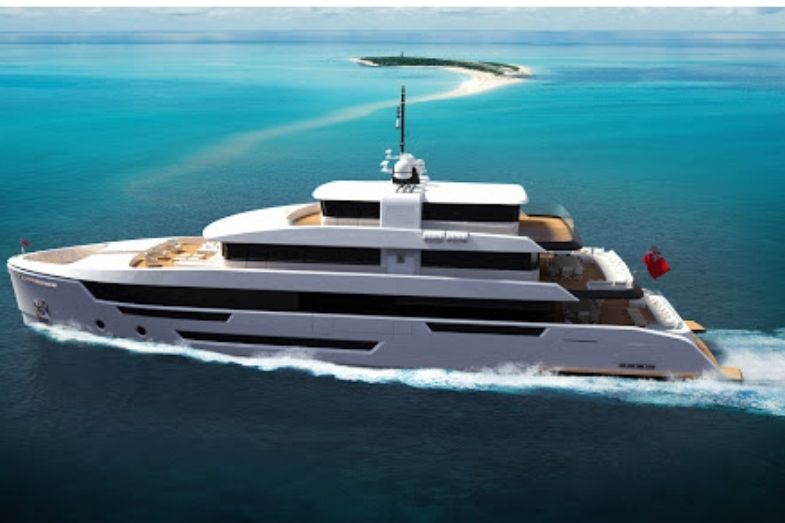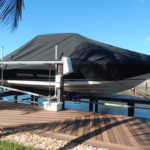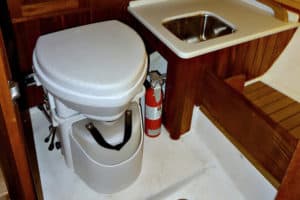What is a boat beam? You may have heard of the term boat beam but are unsure what it is or what it means. In this article, I will describe what the beam of a boat is and its purpose.
What is the beam of a boat? The boat beam is the width of a boat at its widest part. In nautical terms, its full name is “beam overall” or BOA. It is the overall width of a boat, measured at the widest portion of the nominal waterline.
The boat beam largely determines its stability on the water. Generally, the wider the beam, the more stable the boat.
To measure a boat beam, the boat is measured at the widest part, from the left side (port) to the right side (starboard).
Read on to learn more about the boat beam, the boat beam definition, and its purpose.
Boat Beam
The beam is an important part of a boat because it determines the boat’s degree of stability on the water. Another way of putting it is: the beam determines a boat’s handling characteristics. A boat with a narrow beam can go faster than a boat with a wider beam.
However, a narrower boat will not perform well in heavy waves compared to a boat with a wider beam. The narrow section of its beam will make it unstable on heavy waters. Strong waves will cause the narrow-beamed boat to sway to and fro, or it can even sink.
A boat with a wider beam will handle strong waves better because of its wider cross-section. However, it won’t go as fast as a narrower boat because it needs to displace more water as it moves forward. In general, a boat with a wider boat beam will always be more stable than a boat with a narrow beam.
The beam, which refers to the widest point, is an important design element of any watercraft. In nautical terms, there exist two kinds of beams. One is the BOA or “beam overall,” and the other is the BOC or “beam on the centerline.”
BOA is the standard term that is used to refer to the widest point of the boat. BOC is used for vessels with multihulls such as catamarans and trimarans. It is the perpendicular distance measured from the centerline of one hull to the other hull’s centerline.
A boat’s centerline is the imaginary central line going from the boat’s bow to its stern. The bow of the boat is its front end, and the stern is its rear end. In simple boater’s lingo, the bow is the front, and the stern is the rear. The starboard is the right side of the boat, and the port is its left side.
What Is the Origin of the Term “Beam”?
The term originally came from wooden ship designs from the distant past. Large timbers were used in the early days to provide strength to the ships made of wood. These timbers sit on top of every rib. They extend up from the keel and span the whole width of the boat or ship.
There is a deck on top of the ship. This deck is made of smaller wooden boards. It acted as a ceiling for the cabins at the first level of the ship. The inside of the ship resembled a typical house with the floor beams exposed on the floor deck’s underside.
A customary way of determining a ship’s size during those early times is by referring to these roof beams. They used these beams’ sizes to determine how wide the ship is and how that dimension is related to the ship’s length and its other rigs.
How to Measure the Beam of a Boat?
What is beam width on a boat? You need to know how to measure the boat beam width because it will show you if you can safely pass an object on the water or not. When you know what is a boat beam, it will help you in situations on the water.
In measuring the beam on a boat, you will need a ball twine, a carpenter’s square, measuring tape, and some duct tape. Measuring the beam involves two steps, namely measuring the centerline and then measuring the beam.

Measure the Centerline
- Get the measuring tape and measure the width of the stern. Calculate the center of the stern by dividing the width in half. Then mark that halfway point on the deck.
- Get one end of the twine and tape it to that center mark.
- Stretch the twine toward the bow and tape the twine to the bow’s point.
- To make a more accurate measurement, measure the width of the bow. Divide this measurement in half. Then mark the center of the bow. Then stretch the twine from the bow’s center to the stern’s center. This will show you the precise centerline of the deck or boat.
Measure the Beam
- Visually choose the widest part of the boat.
- Get the measuring tape and pull it across the gunwales. This part is the top edge of the hull of the boat. The hull of the boat is its body. Make sure that the tape is perpendicular to the centerline. You can use the carpenter’s square to ensure that the measuring tape is at a 90° angle to the centerline.
- The boat beam width is the distance between the outer edges of the hull.
- If you want to make sure that this is the boat’s widest section, do another measurement.
- Move the tape a few inches ahead and one more time a few inches to the rear of the first measurement you got from number 3.
- If any of these two additional measurements are wider than the one you got in number 3, then that is the boat’s true beam. The point being: the beam on a boat should be the widest point in the boat.
You can also measure the beam at certain specific points on the hull, such as the cargo area or the pilothouse. However, you should designate the names of the structures where you got the measurement.
Naval architects use the beam, along with the length and draft, to design a boat or ship hull for a certain purpose or job using the principle of deadrise. These three measurements, namely length, beam, and draft, together with deadrise, are the factors that determine the shape and handling characteristics of the hull of a boat or a ship.
A Faster Way to Measure the Boat Beam Width
There’s a faster way to measure a boat’s beam, although it is less accurate. You can use it as a rule of thumb when you don’t need an accurate measurement. This is the formula that can be used for monohull watercraft:
Beam = LOA2/3 + 1
Wherein LOA is the same as the overall length of the boat and boat’s hull, which is parallel to the waterline.
The 2/3 exponent means that you have to compute the LOA’s cube root (represented by 3 as the denominator) and then square it (represented by 2 as the denominator).
Here is an example:
Problem: Find the beam of a boat that is 125 feet long.
- First, find the cube root of 125, which is equal to 5.
- Calculate 5 squared, which is 25.
- Add 1 to 25 and you will get 26 – the approximate beam of a 125’ long boat.

Now that you know the answer to “What is the beam of a boat?”, the boat beam definition, and how to determine your boat beam, let’s now discover the relationship between boat beam and stability.
Relation Between Stability and the Beam
The boat’s beam is not only important in determining its passage. It is also crucial in determining its stability. A boat’s stability can only be determined through the application of the principles of mathematics and physics.
However, that goes beyond the scope of this article. I will dwell on the general principles involved in a boat’s beam related to its stability.
A Wider Beam Makes a Boat More Stable
A boat that has a wider beam enjoys higher initial stability. This quality is the boat’s resistance to the center of gravity shifting sideways (left or right). External forces such as waves, wind, and movements of cargoes carried by the boat can cause the boat’s center of gravity to shift, causing it to move to the left or the right.
The stability of the boat beam is also affected if its volume is shifted away from its centerline. Stability will be reduced if most of the volume is near the centerline. This is where a wider beam is more advantageous. A boat with a wider beam will enable its volume to be shifted farther away from the center, making it more stable than a narrow-beamed boat.
But there’s a caveat. A wide-beamed boat has issues with secondary stability. This is the quality of a vessel when it accidentally tips on its side. While a wide-beamed boat can be tough to tip on its side, it will capsize very easily once it does.
However, secondary stability also depends on the bottom shape of the vessel. A boat with a curved bottom has a higher secondary ability than a boat with a square bottom.
A Narrow Boat Beam Makes a Boat Less Stable but Faster
A narrow beam on a boat makes a boat less stable. However, they are generally faster than wider-beamed boats. Boats with narrow beams are also less sluggish and are safer and easier to maneuver around obstacles. They are able to navigate through narrow passageways that wider boats can’t pass through.
What Are Modern Boat Beams?
Boatbuilding and shipbuilding are very different today than they were many decades ago. In today’s modern shipbuilding, steel beams are now used instead of wooden beams. These steel beams are called torsion boxes. The width of one such box can be as wide as twenty people stretched across the hull.
In today’s boats and yachts, wooden beams are no longer exclusively used. Stronger and more durable options are now used. Some of these options include steel, iron, composite material, and Ferro-cement.
Typical Boat Beam Measurements
In designing boats, boat architects use the length to beam ratios to determine how wide the beam of a boat should be. For small boats such as trailerable boats and dinghies that are not more than 20 feet long (6 meters), they use the ratio of 2:1. That means the beam of a boat should be one-half of its length.
For more than 30 ft. (10 m.) long, they use the 5:1 ratio. That means the beam of a boat this size should be one-fifth of its length.
The formula Beam = LOA2/3 + 1 is also used in calculating the beam of a boat. LOA is the overall length of the boat. All units of measurement are in feet.
I will give you some examples to illustrate this length to beam ratios.
- A regular yacht that measures 27 ft. (8.2 m.) long will have a beam of about 10 ft. (3.05 m.) wide.
- A yacht 70 ft. (21.3 m.) long will have a beam that is about 18 ft. (5.5 m.) wide.
- A superyacht that is 741 ft. (25 m.) long will have a beam that is approximately 82 ft. (25 m.) wide.
Conclusion: What Is the Beam of a Boat?
So, what is a boat beam? What does beam mean on a boat? The beam of a boat is the width of the vessel at its widest point. In nautical lingo, it is called beam overall or BOA. It refers to the overall width of a boat, or even a ship, measured at the widest section of the nominal waterline.
A boat with a wider beam is more stable than a boat with a narrow beam. To measure a boat beam, the boat is measured at the widest part, from the left side (port) to the right side (starboard).









![Read more about the article Towee Boats [Models, Specs, and Review]](https://boatinggeeks.com/wp-content/uploads/2021/04/towee-boats-300x200.jpg)